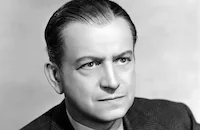Duchess of Idaho

Brief Synopsis
Cast & Crew
Robert Z. Leonard
Esther Williams
Van Johnson
John Lund
Paula Raymond
Clinton Sundberg
Film Details
Technical Specs

Synopsis
Christine Riverton Duncan, the star of the "Melody in Springtime" water ballet, shares her Chicago apartment with Ellen Hallet, a secretary to playboy railroad tycoon Douglas J. Morrissen, Jr.. One evening, while dining at a nightclub with the boring Linda Kinston, Douglas pretends that Ellen is his fiancée to scare off his date. Ellen, who is in love with Douglas, gladly plays the part, and then stays for a drink. At the end of the evening, Ellen returns home drunk and depressed, certain that Douglas does not love her. The following day, Ellen accepts an invitation to join Douglas on a business trip to Sun Valley. Elated, Ellen telephones the news to Christine, who advises her to run out and buy a dress with a "low, wicked neck line." No sooner does Ellen bring home a new dress, than Douglas calls to cancel his invitation. Fed up with Douglas' habit of only calling on Ellen when he needs her help to fend off other women, Christine decides to help her roommate by playing a hoax on Douglas. After boarding Douglas' train to Sun Valley, Christine wins the playboy's affections and then surprises him with hints that she expects marriage. In Sun Valley, complications arise when Christine falls in love with hotel bandleader Dick Layn. Soon after Douglas returns to his office, Ellen bumps her head on her desk and is briefly knocked unconscious. While attending to Ellen's injury, Douglas finally notices her beautiful eyes and invites her to dine with him. Ellen prepares a romantic dinner for Douglas at her apartment, but she begins to lose hope in winning Douglas when he tells her that he will be returning to Sun Valley to resume his romance with a woman he met there. Back in Sun Valley, Christine wins the title of "Duchess of Idaho" in a dance contest, and is about to be proposed to by Dick, when she is distracted by the Douglas' arrival. Dick misinterprets Christine's sudden change in behavior as a rejection, but Christine eventually resumes her romance with Dick when Douglas tells her that he is in love with Ellen. Meanwhile, Ellen, believing that Christine has stolen her man, goes to Sun Valley to straighten matters out. Following a series of misadventures in Sun Valley, the two women lose their men and return to Chicago. A short time later, Dick and Douglas pay an unexpected visit to Ellen and Christine at their apartment, hoping to reconcile with their sweethearts. Ellen immediately rushes into Douglas' arms, and after Christine explains the ruse to Dick, he takes her back with open arms.

Director

Robert Z. Leonard
Cast

Esther Williams

Van Johnson

John Lund

Paula Raymond

Clinton Sundberg
Connie Haines
Mel Torme

Amanda Blake
Tommy Farrell

Sig Arno
Dick Simmons
The Jubalaires
Charles Smith
J. Louis Johnson

Red Skelton

Lena Horne

Eleanor Powell

Roger Moore
Bunny Waters
Dorothy Douglas

Mae Clarke Langdon
John Trebach
Suzanne Ridgeway
Harold Miller
Larry Steers
Gene Brown

John Hamilton
Les Gotcher

Russell Hicks
Ben Heideman
Bert Moorhouse
Wilson Wood
Allen Ray
Bobby Troup
Lorraine Crawford
Sandra Spence
Bullets Durgom
Crew
Peter Ballbusch
Malcolm Brown
Dorothy Cooper
Jerry Davis
Jack Dawn
Jack Donohue
Adrienne Fazan
Herbert Fischer
Jack Franzen
Dave Freidman
Cedric Gibbons
A. Arnold Gillespie
James Gooch
Sydney Guilaroff
Floyd Huddleston
Henri Jaffa
Ray June
Mollie Kent
Arthur Krams
Robert Z. Leonard
Skip Martin
Andrew Marton
Henry Nemo
Warren Newcombe
W. P. O'brien
Joe Pasternak
Lee Pearl
Eddie Polo
Al Rinker
Lorraine Roberson
Helen Rose
Charles Schoenbaum
Albert Sendrey
Douglas Shearer
J. Frank Shugrue
Georgie Stoll
Marvin Stuart
Charles E. Wallace
Edwin B. Willis

Photo Collections
Videos
Movie Clip



Trailer
Hosted Intro
Film Details
Technical Specs

Articles
Duchess of Idaho
In an attempt to create one such opportunity for Ellen to rescue Douglas, Christine masquerades as a marriage-hungry vamp traveling to Sun Valley, Idaho bent on seducing the vacationing Douglas. Things become complicated in the vacation paradise of endless skiing and swimming when Christine finds herself easily romancing Douglas, even as she begins to fall in love with bandleader Dick Layn (Van Johnson) whose group performs every evening in the resort's nightclub. Much romantic tension ensues when Dick and Ellen both become jealous over Christine's continuing flirtation with Douglas.
Esther Williams was a consistent box office draw in the Hollywood of the Forties, ranked as one of the top ten stars in 1949. And the spectacular Technicolor and beautiful Sun Valley locales, along with Williams's crowd-drawing power made Duchess one of the top moneymaking films of 1950 alongside On the Town and Annie Get Your Gun.
The Duchess of Idaho was also Williams's return to the screen after the birth one year previously of her first child, Benjamin Stanton Gage. In her autobiography, The Million Dollar Mermaid, Williams described the enormous professional demands then placed on movie stars, whose newborns were often enlisted into the publicity effort.
"Everyone wanted pictures of a sweet baby and a pretty mother, preferably one who's got her figure back already." Williams complained that, "after an all-too-brief maternity leave, you were expected back on the lot, 'camera ready,' which in my case meant looking good in a swimsuit, so I got in the pool right after Benjie was born." Williams quickly lost the 25 pounds gained during pregnancy, with the MGM publicity department claiming she had even lost an inch off her hips. That same year Williams signed a new contract with MGM guaranteeing her $1,300,000 and $2,500 a week.
It was Williams's fourth pairing with Van Johnson (her last would be 1953's Easy to Love), and much to the actress's chagrin, a return to the formula of the mismatched lovers plot. "As happy as I was to be working once more with Van," she recalled, "the recycled plots were getting to me. At one point I turned to Van and said, 'Didn't we do this scene before in an elevator?" He laughed. "Esther, this is our fourth picture together: We've done this scene in an elevator; at the side of the pool, and we've even done it swimming in the pool together; with you holding me up so I could say my lines and not go blub-blub-underwater." He was not exaggerating...We could laugh about it, but the truth was that there was a definite predictability to the plots of my films. Audiences had come to expect a certain kind of film from me, and these movies were immensely popular."
The New York Times seemed to agree, its critic quipping, "the principals, as well as their surroundings, never looked lovelier than they do in the panchromatic hues of Technicolor and the story is routine and often painfully obvious."
Though some of the thwarted lovers story might have been a return to familiar territory, there was some novelty to distinguish Duchess from the pack, including numerous star cameos. The nightclub scenes in Duchess feature Lena Horne singing "Baby Come Out of the Clouds", an unbilled guest appearance by Red Skelton and a peppy Eleanor Powell boogie-woogie dance number for which Mrs. Glenn Ford came out of retirement.
Director: Robert Z. Leonard
Producer: Joe Pasternak
Screenplay: Dorothy Cooper, Jerry Davis, Sid Fields
Cinematography: Charles Schoenbaum (Technicolor)
Production Design: Cedric Gibbons, Malcolm Brown
Music: Al Rinker, Floyd Huddleston, Henry Nemo, Lee Pearl, M. Beeby, G.M. Beilenson, Kermit Goell, Fred Spielman
Cast: Esther Williams (Christine Riverton Duncan), Van Johnson (Dick Layn), John Lund (Douglas J. Morrison, Jr.), Paula Raymond (Ellen Hallet), Clinton Sundberg (Matson), Connie Haines (Peggy Elliott), Mel Torme (Cyril).
C-99m. Closed captioning.
by Felicia Feaster

Duchess of Idaho
Quotes
Trivia
'Eleanor Powell' 's last film.
Notes
A January 1949 Hollywood Reporter news item noted that some location shooting was set to take place in Sun Valley, Idaho. This picture marked the final screen appearance of actress Eleanor Powell and the motion picture debut of composer, musician and actor Bobby Troup (1918-1999).
















